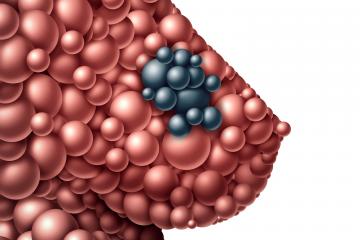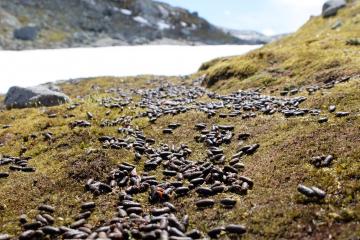Artikkel
A novel antibiotic idea: Preventing bacterial stickiness

A novel antibiotic idea: Preventing bacterial stickiness
Antibiotics most commonly work by killing bacteria, for example by destroying their cell wall or by interfering with protein synthesis. Now researchers at UiO are launching a completely new idea: They want to prevent bacteria from sticking to a substrate, before an infection can even occur.
Researchers within the Dirk Linke group in the Department of Biosciences are now proposing this as a new method to fight the bacterium Yersinia enterocolitica, which causes severe diarrhea in an estimated ten million children each year - mainly in the world's poorest countries. This strategy should give the pharmaceutical industry a new weapon in the fight against the antibiotic-resistant bacteria, which is a major and growing problem in both rich and poor countries. It could also be used for instance to inhibit bacteria from binding to prostheses and implants, forming large colonies termed ‘biofilms’.
In addition, the researchers see several possible applications in industry, such as shipping and the aquaculture, where bacteria and biofilms can be a big problem. It is all about attacking the bacteria in a completely new way, the researchers say.
Inhibiting a bacterium’s "Velcro"
"For bacteria to cause an infection, they must first attach to a surface, such as the cells in our body. The same applies when bacteria form biofilms; then they must attach themselves to a surface. Bacteria have evolved to have a number of number of "techniques" that make this possible", says Professor Dirk Linke.
One of these tricks is to produce very sticky molecules – termed adhesins - that cover the bacterial cell surface. Thus, a bacterium can use the adhesins to attach to a substrate, or to make a biofilm by attaching itself to other bacteria. ‘By interfering with the production of the adhesins, we can potentially fight infections already in the start-up phase - that is, before the symptoms occur’, postdoc Marcella Orwick-Rydmark adds.
Adhesins are long hair-like proteins with a sticky tip. These hairs can grow so tightly that they more or less cover the bacterial cell surface, as if the bacteria were covered in Velcro. Dirk Linke and his team of researchers, including Marcella Orwick-Rydmark and Daniel Hatlem are now the first to describe how these Velcro-like hairs - that is, the adhesins - are produced inside the bacterial cells and transported to the surface. They have also studied how it is possible to block this process. The new findings were presented in a recent scientific article published in Molecular Microbiology.
Blocking the transport of adhesins to the cell’s surface will in practice cause the bacteria to lose their ability to attach to anything. Then they cannot make biofilms or cause infections, the researchers believe.
Long-term work
10 years of hard work lies behind this new discovery. The Yersinia adhesins that were studied in this particular project were discovered nearly 10 years ago, and it was within the last two years that Dirk Linke’s group has discovered how they were transported to the cell surface, and how they can genetically block this process.
They believe that these discoveries are far reaching, as adhesins are important in other diseases such as tuberculosis, plague and cystic fibrosis. Artificial hips and other surgical implants can also become covered by biofilms, which can cause such serious infections and the eventual removal of implants, which is painful and expensive. It is also relatively common for people with urinary tract infections to develop biofilm-like structures within the cells along the urinary tract, and this can act as a reservoir for new infections.
"We therefore believe that this is a major advance when we have now shown how we can block the production of a ’Velcro protein’ in a bacterium. But I want to emphasize that it will still take time before we can present a new drug. We may need another five to ten years of continued research and development work", says Linke.
Want more research news about science and technology? Follow Titan.uio.no on Facebook or subscribe to our newsletter
Mutations prevent the formation of adhesin molecules
The researchers describe in their scientific article how adhesin proteins are produced by Yersinia enterocolitica. They have also studied which parts of the protein are central during transport from the inside of the bacterium to the cell membrane. In addition, the researchers have introduced mutations that block this process.
“We have come a long way in understanding which part of the adhesin protein can be blocked by mutations. The next step is to develop a molecule that binds to that part of the protein, and this can become a future drug. This then becomes a fairly classic development project, which we have good opportunities to carry out here at UiO and the Norwegian Center for Molecular Medicine (NCMM)”, says Linke.
Marcella Orwick-Rydmark emphasizes that the bacteria do not die if they are exposed to a drug that only destroys the adhesin production. This can actually be an advantage because the bacteria are less likely to develop new defense mechanisms through evolution. A bacterium that is unable to produce adhesin can still be able to reproduce.
“No drugs have been developed previously that attack these adhesin molecules. This means that the bacteria cannot use any of the "old" techniques they have developed to protect themselves against antibiotics”, she adds. Additionally, drugs that target adhesin molecules could also be used in combination with classical antibiotics, leading to even better outcomes for someone with an infection.
Biofilms are everywhere
The UiO researchers have already received considerable feedback from other interested researchers. During the coming months they will, among other things, present the new findings at several scientific conferences.
Biofilms are more widespread than most people might think about. For example, the rings that form in our toilets and bathtubs are examples of biofilms, as well as the plaque on our teeth. Biofilms also exist practically everywhere in nature where there is a solid surface surrounded by water. You have probably noticed that stones in running water can be very slippery – this is due to biofilms that contain many different bacterial species. But these are the not the biofilms that Linke, Hatlem, and Rydmark are planning to target – yet.
Contact:
Professor Dirk Linke, Department of Biosciences
Postdoctoral fellow, Marcella O. Rydmark, Department of Biosciences
PhD student, Daniel Hatlem, Department of Biosciences
Read more on Titan.uio.no:
- Fur trade may have spread the plague through Europe
- Norwegian evolutionary biologists pushed the frontiers in international science
- The strange genetics of the fish that newer grows up
Read the scientific articles:
Nandini Chauhan, Daniel Hatlem, Marcella Orwick-Rydmark, Kenneth Schneider, Matthias Floetenmeyer, Barth van Rossum, Jack C. Leo and Dirk Linke: Insights into the autotransport process of a trimeric autotransporter, Yersinia Adhesin A (YadA). Molecular Microbiology. First published: 01 January 2019.
Nandini Chauhan, Agnieszka Wrobel, Mikael Skurnik and Jack C. Leo: Yersinia adhesins: An arsenal for infection. Proteomics Clinical Applications, 12 April 2016.
Shakeel A. Shahid, Madhu Nagaraj, Nandini Chauhan, Trent W. Franks, Benjamin Bardiaux, Michael Habeck, Marcella Orwick-Rydmark, Dirk Linke and Barth-J. van Rossum: Solid-state NMR Study of the YadA Membrane-Anchor Domain in the Bacterial Outer Membrane. Angewandte Chemie International Edition, 31 August 2015.
Kategorier
Aktuelt
Mest lest siste syv dager
Feil!
Forespørsel om mest lest returnerte en feilmelding.
Nyheter fra andre
Les også
Sovjetisk lærdom: Pestbakterien kan kontrolleres, men ikke utryddes
Myndighetene i Sovjetunionen brukte enorme ressurser – og enorme giftmengder – i et forsøk på å utrydde pestbakterien som blant annet forårsaket Svartedauden. Bakterien lot seg ikke utrydde, men til gjengjeld lærte sovjeterne en bedre strategi for å bekjempe slike sykdommer.
Proteiner avslører kreftsvulstens hemmeligheter
Det finnes 10 000 forskjellige brystkreft-proteiner. Nå har forskere klart å kartlegge dem alle. Det kan gjøre det lettere å velge riktig behandling og å utvikle nye medikamenter.
Stemmer det at hver sjuende bølge er ekstra høy?
Svaret er nei. Men også litt ja.
«Love Is The Seventh Wave» sang Sting på albumet The Dream of the Blue Turtles i 1985. Han hadde nok verken matematikk eller fysikk i tankene.
Kan denne lemenbæsjen fortelle noe om årsaken til lemenår?
En student og en forsker krabber rundt i fjellheimen ved Finse på jakt etter bæsj fra lemen og andre gnagere.





